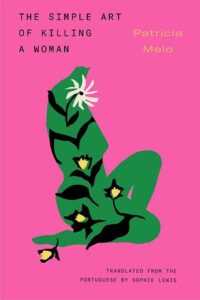Book review: The Simple Art of Killing a Woman by Patrícia Melo
 For about six months now I’ve been subscribing to the Good Book Club. Their ethos is intersectional feminist fiction from women, queer men and writers who identify as non-binary. They only choose books from indie publishers and celebrate diverse stories, often in translation. Since March, in addition to being a monthly postal subscription, they run an online book group to discuss that month’s book.
For about six months now I’ve been subscribing to the Good Book Club. Their ethos is intersectional feminist fiction from women, queer men and writers who identify as non-binary. They only choose books from indie publishers and celebrate diverse stories, often in translation. Since March, in addition to being a monthly postal subscription, they run an online book group to discuss that month’s book.
Their April book exemplified all the above. The Simple Art of Killing a Woman by Patrícia Melo (translated by Sophie Lewis) is a Brazilian novel about violence against women, with a particular focus on Indigenous women. It’s angry, funny, provocative and gave us a lot of fodder for discussion in the book group.
An unnamed young lawyer from Sao Paolo narrates this story. After she is hit by her boyfriend she takes a temporary project on the other side of Brazil. It’s a study of femicide cases in Rio Branco, a small city near the border of Bolivia in Acre, a rainforest region. The narrator attends court cases, interviews fellow lawyers and the families of the deceased.
“In Acre…the gales that time of year had nothing in common with the tropical storms we were used to elsewhere in the country. Here it was like a trailer for the end of the world, almost always preceded by a kind of suspense, as if, suddenly, every single heartbeat had been forced to pause. In an instant, the sky would fill with a dense, low ceiling of black cloud, the temperature would spike, the pressure plummet, and the noise and fury of the wind and thunderclaps would ring through your body. You’d feel so tense that, when the torrent finally descended and flooded the city, all you wanted to do was yell with relief. And then everything stopped working.”
She quickly becomes emotionally involved, particularly in the circumstances around the murder of Txupira, a local Indigenous teen who was almost certainly killed by three rich white young men. Through this case she meets local lawyer Carla and local journalist Rita. With their encouragement she starts asking questions, which does not go down well with most other Rio Branco residents.
The narrator also befriends Marcos, a local multiracial man who takes her to meet his mother in the Ch’aska Indigenous community. The Ch’aska live in the rainforest and try to keep their traditions alive through art and ceremony, including the use of ayahuasca. In a series of ayahuasca rituals, the narrator experiences visions that blend past and present reality with mythology and folklore. She sees – and sometimes inhabits the character of – women warriors, ready and able to exact revenge for the ills they have suffered. These passages are sometimes a little hard to follow, filled with non-sequiturs and sudden changes of scene or people.
The main story is also interspersed with short poems about women who have been murdered. Unlike the ayahuasca sections, these are very clear and matter of fact, which makes them equally hard to read. I loved the inclusion of these as an insight into all the many femicide cases that couldn’t be covered in detail in a short novel. It’s a clever shorthand, one that made me stop and take a deep breath each time.
The narrator’s own past and fears about her current relationship overlap with the horrific situations she sees every day in court. The language gets pretty graphic at times (though never gratuitously so). Melo is not subtle. Most of the men are bad ‘uns. Which I can see being offputting for some readers but I loved this. Melo is angry and I can understand that.
“Of course they aren’t born like this. Only a few are born to murder. But psychopaths are an elite class of murderer. The general working mass of murderers, the majority of them, I’d say, have to learn to hate before they can kill…But there’s nothing easier than learning to hate women. There is no shortage of teachers. Fathers teach it, the state teaches it, the legal system teaches it, the market teaches it, and culture, and propaganda.”
I didn’t really notice it until the book group discussion, but The Simple Art of Killing a Woman is structured as a thriller. (It might seem odd not to have noticed that, but it felt quirky and literary while reading it.) It’s certainly not a conventional thriller, but on reflection I can see a clear relationship to books like Deep Water by Patricia Highsmith. The whodunnit element isn’t nearly as important as the psychological exploration of why these men murder women, how society enables them, or shapes them into murderers in the first place.
Melo is a multiple-award-winning Brazilian writer of novels, short stories, plays and screenplays. A few more of her novels have been translated into English and I will definitely be adding them to my wishlist.
Mulheres empilhadas published 2019 by Leya.
This translation first published 2023 by Restless Books in the US. UK edition published 2024 by The Indigo Press.